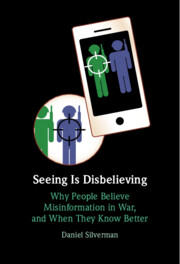Book contents
- Seeing Is Disbelieving
- Seeing Is Disbelieving
- Copyright page
- Dedication
- Contents
- Figures
- Tables
- Preface and Acknowledgments
- 1 Introduction
- 2 A Theory of People’s Factual Beliefs and Credulity in War
- 3 Factual Misperceptions in the US Drone Campaign in Pakistan
- 4 Proximity to the Fighting and the Puncturing of Factual Bias in Iraq
- 5 Truth Discernment and Personal Exposure in the Syrian Civil War
- 6 Understanding and Mitigating the Appeal of Falsehood in Wartime
- Appendix
- References
- Index
2 - A Theory of People’s Factual Beliefs and Credulity in War
Published online by Cambridge University Press: aN Invalid Date NaN
- Seeing Is Disbelieving
- Seeing Is Disbelieving
- Copyright page
- Dedication
- Contents
- Figures
- Tables
- Preface and Acknowledgments
- 1 Introduction
- 2 A Theory of People’s Factual Beliefs and Credulity in War
- 3 Factual Misperceptions in the US Drone Campaign in Pakistan
- 4 Proximity to the Fighting and the Puncturing of Factual Bias in Iraq
- 5 Truth Discernment and Personal Exposure in the Syrian Civil War
- 6 Understanding and Mitigating the Appeal of Falsehood in Wartime
- Appendix
- References
- Index
Summary
This chapter builds the theory about how civilians form factual beliefs in war, walking through the two major factors that power the theoretical engine behind the book’s argument. First, it explores the role of people’s psychological motivation in how they think about the world and its application to belief formation in war zones. In general, people will be motivated to interpret events in a way that fits their prior worldviews in the dispute, but not everyone will do so: for those who are closer to the action, such biases are outweighed by an “accuracy motive” and the need to get it right. Then, it discusses the role of people’s information sources in shaping their factual beliefs. The media in conflict zones is particularly prone to fueling factual biases, but not everyone is equally vulnerable: those more directly exposed to the relevant events will often reject biased narratives due to their community’s local information about what is actually taking place. Ultimately, the chapter weaves these two factors together, showing how they jointly ensure that fake news spreads widely in war, but those who are close enough to the action tend to be more resilient and know better.
Keywords
- Type
- Chapter
- Information
- Seeing Is DisbelievingWhy People Believe Misinformation in War, and When They Know Better, pp. 18 - 52Publisher: Cambridge University PressPrint publication year: 2024



